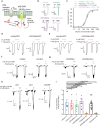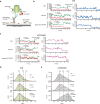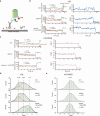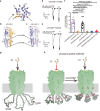Mechanism of human α3β GlyR regulation by intracellular M3/M4 loop phosphorylation and 2,6-di-tert-butylphenol interaction
- PMID: 40473619
- PMCID: PMC12141631
- DOI: 10.1038/s41467-025-60516-8
Mechanism of human α3β GlyR regulation by intracellular M3/M4 loop phosphorylation and 2,6-di-tert-butylphenol interaction
Abstract
α3β glycine receptor (GlyR) is a subtype of GlyRs that belongs to the Cys-loop receptor superfamily. It is highly expressed in the spinal dorsal horn where sensory information is integrated. Under inflammatory conditions, the large unstructured intracellular M3/M4 loops of the α3 subunit are phosphorylated through the prostaglandin E2 (PGE2) pathway, inhibiting ion conduction, and resulting in elevated pain sensation. A small molecule analgesic analog, 2,6-di-tert-butylphenol (2,6-DTBP) potentiates phosphorylated α3β GlyR through unclear mechanisms and relieves pain. Combining cryo-Electron Microscopy (cryo-EM) structures and single molecule Förster resonance energy transfer (smFRET) experiments, we show compaction of M3/M4 loop towards the ion conduction pore upon phosphorylation and further by 2,6-DTBP binding, which in turn modulates function through changing pore conformations and local electrostatics. We show that simultaneous interactions with the M3/M4 loop and the transmembrane domain (TM) is necessary for the potentiation of heteromeric α3β GlyR by 2,6-DTBP, while TM interaction alone is sufficient to potentiate homomeric α3 GlyR, explaining the mystery of why 2,6-DTBP potentiates only phosphorylated α3β GlyR. These findings show how post-translational modification of the unstructured intracellular M3/M4 loop may regulate Cys-loop receptor function, providing new perspectives in pain control and other pharmaceutical development targeting GlyRs and other Cys-loop receptors.
© 2025. The Author(s).
Conflict of interest statement
Competing interests: The authors declare no competing interests.
Figures






Update of
-
Mechanism of human α3β GlyR modulation in inflammatory pain and 2, 6-DTBP interaction.Res Sq [Preprint]. 2024 Aug 7:rs.3.rs-4402878. doi: 10.21203/rs.3.rs-4402878/v1. Res Sq. 2024. Update in: Nat Commun. 2025 Jun 5;16(1):5242. doi: 10.1038/s41467-025-60516-8. PMID: 39149480 Free PMC article. Updated. Preprint.
References
-
- Lynch, J. W. Molecular structure and function of the glycine receptor chloride channel. Physiol. Rev.84, 1051–1095 (2004). - PubMed
-
- Lynch, J. W. Native glycine receptor subtypes and their physiological roles. Neuropharmacology56, 303–309 (2009). - PubMed
-
- Yu, H., Bai, X. C. & Wang, W. Characterization of the subunit composition and structure of adult human glycine receptors. Neuron109, 2707–2716.e2706 (2021). - PubMed
MeSH terms
Substances
Grants and funding
LinkOut - more resources
Full Text Sources

